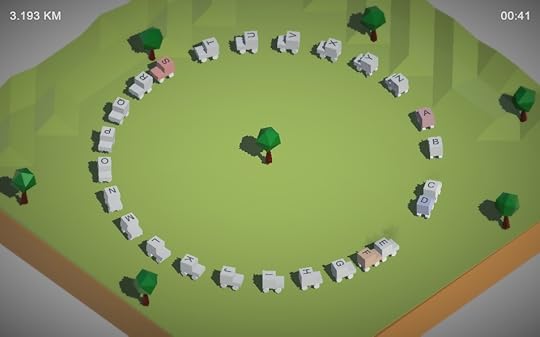Kill Screen Magazine's Blog, page 247
July 29, 2015
Fran Bow's upcoming horror depicts a young girl's trauma after losing her parents
Fran Bow has been in production for three years but only now has it got its first official trailer. Oh, and a release date of August 27th. Before you get to watching that trailer, a warning: it is not for the faint of heart.
The game is about Fran Bow, a young girl struggling with seeing her own parents dismembered in her home and an unspecified mental illness, who decides to escape after waking up in a mistrustful mental asylum. Fran’s journey to reunite with her beloved cat, Mr. Midnight, and return to her Aunt Grace’s home is riddled with terrifying visions that vary between gore-laden sequences set in what seems like a parallel nightmare realm, and more bizarre and fantastical scenes involving demonic storybook creatures, steampunkish machinery, and… a family of pinecones? Yeah, it’s weird.
You’ll also be able to play as the cat
The chilling contrast between Fran Bow's cartoonish, pastel-colored world and startling violence calls to mind the paintings of pop surrealist Mark Ryden. Aside from its disturbing visuals, Fran Bow will also feature an enormous cast of characters, some old-school adventure game-style puzzles, and a few arcade-inspired mini-games. You’ll also be able to play as the cat! For a similarly violent and feline-filled horror adventure, you should also check out The Cat Lady by Harvester Games.
Fran Bow launches on Windows, Mac, and Linux on August 27 alongside a free demo.
Skype Heartbreak Show explores the distance of intimacy in the digital age
From how far away can you get close to someone?
Dropsy the clown is looking positively sopping wet
There is a vocal contingent of the Kill Screen staff that does not like to even put their eyes upon Dropsy. They will not speak his name. The big, doughy clown, who stars in an upcoming, eponymous point-and-click adventure game, straddles an uncomfortable line of realistic heft and cartoonish, Gumby-like appendages; his face is clearly the stuff of evil-clown rubber masks, but there's a vacancy to his yellow eyes that somehow counteracts it; I assume when he makes sounds, they are sorta weird moans or something.
This new video of the game adds a new discomfiting touch: apparently the game is also very damp. It fades between scenes with squishing, splashing sounds. There is urine and goo and water all over the place. The game has a sumptuously animated look, and this video shows off a fetishistic eye for detail in the cutscenes, but it also seems to be splitting the difference between pixel art and shitty claymation. Everything appears to be melting. The one thing the anti-Dropsy contingent did not need was an impression of the tactile sensation of Dropsy the clown. They now have it.
Dropsy will not be cowed.
Watch the trailer, then take a shower. The game comes out September 10.
Tough Love Machine: a puzzle of 8-bit companionship
Like relationships themselves, representing the struggles of love in a digital format can be difficult. Andrew Morrish does just that in his newest game, Tough Love Machine.
Tough Love Machine offers up a simple premise: unite two hearts. Like so many puzzle games before it, in execution this becomes a challenge as you move the hearts around obstacles using independently controlled left and right “hands,” never letting them fall offscreen to their demise.
in the game, as in love, “There is no undo button.”
The room is silent when you begin, all 8-bit neon on a solid black background. The intro screen offers nothing but basic controls. As you move each hand, each step pushes forward a musical scale and the connection or eternal separation of the would-be lovers. Text along the bottom of the screen is far from encouraging, such as one level which reminds you that in the game, as in love, “There is no undo button.”

For your success, you are offered a short MIDI-style jingle and garish carnival-esque light show before being transported to the next challenge, leaving you with the sense that love will never be easy, even if it does have its rewards.
Tough Love Machine is available to play on Newgrounds, Kongregate, itch.io, and Gamejolt.
Telltale���s Game of Thrones officially sucks now
Whether you like HBO’s Game of Thrones or not, you will find nothing redeemable in its videogame version.
It's about time digital art had a place to call home
Mister Rogers' Neighborhood was the first time I saw something resembling a digital frame. The technological magic of his "Picture Picture" device looked like an ordinary painting in a garishly gilt frame until Mister Rogers wanted to show viewers a video. “Hello,” it would sometimes greet him, before then launching into a story about the industrialized creation of crayons or some other every day object. When the video was over Mister Rogers would bid the frame goodbye and the screen would morph back into a generic landscape painting.
Decades later and digital picture frames belong to the lackluster luxury end of the consumer electronic market—the kind of thing you might get from your an older Aunt who doesn’t know you too well when forced into contact around the holidays. Bill Gates believed in them. At some point, his home actually included framed displays that would circulate images depending on the nearest viewers. Guests wore pins which transmitted their aesthetic tastes allowing his home galleries to conform to their preferences.
Most digital art isn’t framed
But in many ways these digital displays were the equivalent of using the invention of celluloid photographic film to record static shots in the early days of cinema. The magic and beauty of film was in how it could be manipulated through movement and editing. The magic of a digital picture frame isn’t in the fact that it can switch between late French impressionism and early Chinese ink wash painting, but in the new kinds of art it makes possible through the possibilities of its display.
Most digital art isn’t framed and doesn’t have a physically curated home. It exists on personal hard drives or in the cloud on someone else’s servers, strewn across Tumblr pages and Twitter feeds, often popping up with little context surrounding its creation or meaning. One group is trying to change that by creating Europe’s first Museum of Digital Art.
The Digital Arts Association, the group behind the initiative, took to Kickstarter to fund the costs associated with developing a space for the MuDA. To be housed on the ground floor of Switzerland’s first high-rise building, the Herdern Hochhaus, the museum plans to host various panel discussions and computing workshops in addition to three exhibitions throughout the year. The initial round of funding from the Kickstarter campaign is said to go mainly toward construction aimed at bring the space up to code and making it hospitable. Because the overhead costs associated with curating and maintain digital art are low, the ongoing costs of maintaining the MuDA are expected to be covered through patron donations and government subsidies.

As for the exhibitions themselves, the Digital Arts Association claims, “Each exhibition is dedicated to one solo artist or artist collective.” Furthermore, “The artists are selected entirely on the basis of their work. Each chosen artist is given as much freedom as possible to curate their own exhibition, while the MuDA team functions as a facilitator.”
The DAA also outlines three principles that will guide them in organizing the museum, including an emphasis on art predicated on code, the belief that “technology is at its very best when it is invisible,” and an adherence to the maxim of “less but better.” Ultimately, they aim for the MuDA to be “a space fostering experiments and discussions.”
Understanding the sublime architecture of Bloodborne
The secret to understanding the Souls games is through their architecture.
July 28, 2015
Oxenfree puts a supernatural twist on wartime numbers stations
There’s something creepy about radios. They’re an iconic device in the Silent Hill series, which used them to mark the presence of nearby monsters with an eerie, warped static. Horror movies like to possess them to play spooky old-timey tunes at unexpected times, or convey cryptic warnings to unsuspecting protagonists. Before games and television, they served as a home for horror and mystery programs.
But even outside of fiction, there are numbers stations: real, Cold War-era shortwave transmissions used to broadcast coded messages that would sound like nonsense to anyone without the key needed to decipher them.
Night School Studio sees the potential in radio’s bizarre history and technology. They’ve been publishing a series of posts on their blog titled Radio Days, which provide a brief history on aspects of the technology in relation to their upcoming supernatural adventure game, Oxenfree.
these radio transmissions are probably haunted
Oxenfree follows the adventure of Alex and a group of partying teens who unleash a ghost on the enigmatic Edwards Island. According to Night School’s most recent blog post, Edwards Island is home to a decommissioned military base, which may play a role in the game’s supernatural mysteries.
With her radio, Alex can cycle through frequencies and possibly pick up some of these strange transmissions. Only instead of coded spy messages, these radio transmissions are probably haunted.
Night School provides some links for those curious about numbers stations: The Conet Project for compiled recordings of various transmissions over the years, and an episode on the podcast 99% Invisible, which is about the numbers stations still up and running today, and the people who tune in.
Oxenfree is headed to PC in late 2015.
Error-Prone demonstrates why self-driving cars are more trustworthy than you
If you're a driver (that is, you drive a car) then you've probably been caught up in a phantom traffic jam at least once. These are the types of traffic jam that have no obvious cause. No one has crashed and the police are nowhere in sight. So what happened? Our own human imperfections, that's what happened.
humans are hopeless and should probably not drive cars.
As explained to BBC journalist Andrew Marr in this short investigation into the phantom traffic jam, they're usually caused by one asshole (I'm being kind) braking more than usual after getting too close to the vehicle in front. This then leads to the car behind them braking, and then the one behind them, gradually building up a chain of cars all braking. This causes the traffic flow to slow down until, eventually, the pile-up comes to a halt some several hundred meters back from the original, annoyingly minor incident.
The phantom traffic jam might be held as evidence that humans are hopeless and should probably not drive cars. In 2010 there were, on average, between 2000 and 3000 deaths every month caused by traffic accidents in the US alone. This is all due to our own shoddiness as humans and is a primary reason as to why the idea of self-driving cars is appealing. Take us out of the equation—with our brains that can tire and become distracted—and replace us with machines that can drive with a precision we can never hope to reach as a species. Problem solved?

The answer to that question won't be known until, you know, driverless cars are the common way to get around. There is the chance of it all going completely wrong and causing mass pile-ups and death. There's always that chance, but in all likeliness, any incident caused by a malfunctioning AI will probably not amount to how damn proficient we are at killing each other in cars. That's one thing we can definitely do better than machines (for now).
You shouldn't need it, but if you do require further proof of our own incapability when it comes to driving cars, then you should check out Error-Prone. It's a small interactive experiment that you can conduct by yourself or with up to 25 other people (one for each letter of the alphabet) that "illustrates perfectly how self driving cars are vastly superior to their human counterparts in terms of traffic grid lock, efficiency and avoiding road accidents."
can you entrust your life to a machine?
All you have to do is select a letter on the keyboard, press it, and you'll have control over the car it corresponds to on-screen. All the other cars are looping in a circle at the same speed and distance from each other. They do this autonomously. You have to match that so you don't cause an accident. Don't press the button too much so that you end up in back of the car in front of you. And don't slow down so much that the cars behind you have to brake and a pile up occurs. That's all you have to do.
Of course, no matter how attentive you are, you'll fail at some point. That's the whole point of this exercise: to prove that humans cannot match machine precision and endurance as much as we may try. As the creators of Error-Prone write in its description: "The only way to win is to not play at all."
You may argue that this virtual experiment doesn't really hold up against what the real-world results may be. After all, you can hardly control the acceleration of your little car with just that one button. That's not a fair test, surely? Well, actually, this exact experiment was once tested out by people at the New Journal of Physics with real cars driven by real people. It was titled "The Mathematical Society of Traffic Flow" and you can watch what happens in the video above.
If you haven't watched it yet, I'll spoil it: a traffic jam forms. In fact, the experiment is used as evidence for the "physical mechanism of forming a jam." Face it, we humans cannot drive without causing traffic jams and accidents. Self-driving cars should be able to avoid them providing the engineering holds up. The only question is this: can you entrust your life to a machine? Given the statistics it seems that doing so would be less dangerous than putting your life in your own hands.
You can play Error-Prone for free in your browser on itch.io.
Kill Screen Magazine's Blog
- Kill Screen Magazine's profile
- 4 followers



